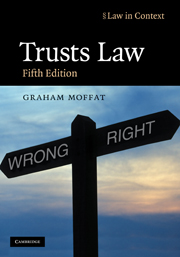Book contents
- Frontmatter
- Contents
- Preface to the fifth edition
- Acknowledgments
- Table of abbreviations
- Useful websites
- Table of statutes
- Table of statutory instruments
- Table of cases
- 1 Trusts introduced
- 2 The evolution of the private express trust
- 3 Taxation, wealth-holding and the private trust
- 4 Creating the trust – I
- 5 Creating the trust – II
- 6 Trusts and public policy
- 7 Flexibility in relation to beneficial entitlement
- 8 The taxation of private trusts
- 9 An introduction to trustees and trusteeship
- 10 Aspects of the management of trusts
- 11 Trusteeship, control and breach of trust
- 12 Implied trusts and the family home
- 13 Trusts in commerce I: occupational pension schemes
- 14 Trusts in commerce II: commerce and equitable remedies
- 15 Trusts in commerce III: commerce, credit and the trust
- 16 Trusts in commerce IV: fiduciary relationships, commerce and the trust
- 17 Trust, contract and unincorporated associations
- 18 An introduction to the law of charity
- 19 A legal definition of ‘charity’
- 20 The regulation of charities
- Index
17 - Trust, contract and unincorporated associations
- Frontmatter
- Contents
- Preface to the fifth edition
- Acknowledgments
- Table of abbreviations
- Useful websites
- Table of statutes
- Table of statutory instruments
- Table of cases
- 1 Trusts introduced
- 2 The evolution of the private express trust
- 3 Taxation, wealth-holding and the private trust
- 4 Creating the trust – I
- 5 Creating the trust – II
- 6 Trusts and public policy
- 7 Flexibility in relation to beneficial entitlement
- 8 The taxation of private trusts
- 9 An introduction to trustees and trusteeship
- 10 Aspects of the management of trusts
- 11 Trusteeship, control and breach of trust
- 12 Implied trusts and the family home
- 13 Trusts in commerce I: occupational pension schemes
- 14 Trusts in commerce II: commerce and equitable remedies
- 15 Trusts in commerce III: commerce, credit and the trust
- 16 Trusts in commerce IV: fiduciary relationships, commerce and the trust
- 17 Trust, contract and unincorporated associations
- 18 An introduction to the law of charity
- 19 A legal definition of ‘charity’
- 20 The regulation of charities
- Index
Summary
Trusts within the rules of an association
It will be seen in Chapters 18–20 that the trust has come to play an important part in the context of not-for-profit activity that the law regards as charitable. But the trust also has an important role to play, alongside other legal concepts such as contract, in non-charitable not-for-profit activity. Numerous not-for-profit organisations are formed not as companies or any other kind of corporate body, but as unincorporated associations. In Conservative and Unionist Central Office v Burrell [1982] 1 WLR 522 Lawton LJ suggested that an unincorporated association will have the following features:
(i) two or more persons bound together for one or more common purposes (not being business purposes);
(ii) having mutual rights and duties arising from a contract between them;
(iii) in an organisation with rules to determine who controls it and its funds and on what terms; and
(iv) which members must be able to join or leave at will.
This last named requirement is contentious unless it means that membership is voluntary, since many unincorporated associations are likely to have rules which impose some restrictions on membership (see also Underhill and Hayton p 163 for a similar criticism).
The trust concept is invoked when the rules make provision – as they do commonly, but not in every case – for the property collectively owned by the association's members to be vested in the names of trustees.
- Type
- Chapter
- Information
- Trusts LawText and Materials, pp. 887 - 912Publisher: Cambridge University PressPrint publication year: 2009



